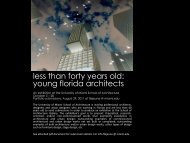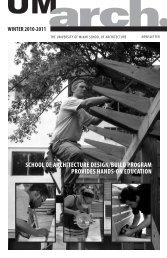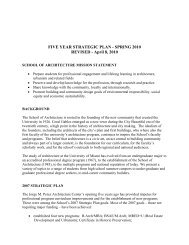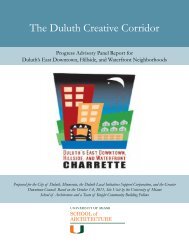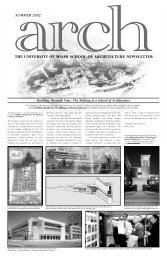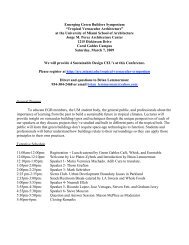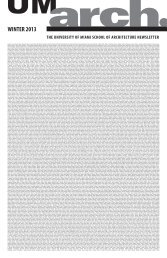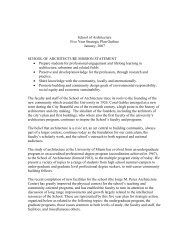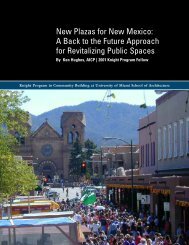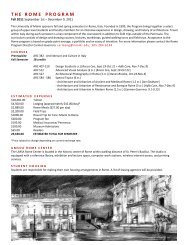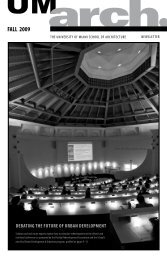Full Report - Knight Program in Community Building
Full Report - Knight Program in Community Building
Full Report - Knight Program in Community Building
You also want an ePaper? Increase the reach of your titles
YUMPU automatically turns print PDFs into web optimized ePapers that Google loves.
HURLEY | THE PUBLIC PROCESS6So what does all of this have to do with New Urbanism? New Urbanists arestruggl<strong>in</strong>g to develop answers to problems that others have already addressed, orat least have studied much longer than we have. To illustrate this po<strong>in</strong>t, I willcompare current consensus-build<strong>in</strong>g practices with New Urbanist charrettes, po<strong>in</strong>t<strong>in</strong>gout ways that New Urbanists could <strong>in</strong>corporate the lessons from consensus-build<strong>in</strong>g<strong>in</strong>to their practices.Theory and PracticeTheory and practice are closely related endeavors <strong>in</strong> the field of consensus-build<strong>in</strong>g.Most academics also practice, and many practitioners contribute to research projects.Professional associations and conferences <strong>in</strong>clude a diverse mix of academics andpractitioners. Consensus-build<strong>in</strong>g practice draws on several streams of well-def<strong>in</strong>edtheory, <strong>in</strong>clud<strong>in</strong>g social psychology, group dynamics, conflict resolution/mediation,systems theory, social network theory, organizational learn<strong>in</strong>g, fem<strong>in</strong>ist theory,and cultural theory. The relationship between consensus-build<strong>in</strong>g theory to practiceis robust: practitioners use theory to ga<strong>in</strong> a deeper understand<strong>in</strong>g of their work;theoreticians test their theory through practice.In contrast, modern-day charrettes seem to be primarily practice-based, draw<strong>in</strong>gvery little from theory. Academics <strong>in</strong> architecture and plann<strong>in</strong>g pay almost no attentionto the way the fields are practiced, and there is very little academic analysis ofcharrette processes. Practitioners believe that charrettes can produce better qualityplans through local <strong>in</strong>put, <strong>in</strong>terdiscipl<strong>in</strong>ary teams, short feedback loops, focusedattention, the creative environment, and public filter<strong>in</strong>g of ideas. A related belief isthat charrettes build support for the plan by creat<strong>in</strong>g a high-quality plan and hav<strong>in</strong>gan open process. These beliefs are empirical; we believe them because we see themto be true <strong>in</strong> practice. However, they are primarily descriptive, and not normative.They describe what happens, but not why it happens. The lack of theory underly<strong>in</strong>gour practice means that we stumble <strong>in</strong> the dark. We do not have an understand<strong>in</strong>gof the dynamics of the overall process, an understand<strong>in</strong>g that could give us directionwhen th<strong>in</strong>gs go wrong.Lesson: A close relationship between theory-build<strong>in</strong>g and practice developmentcan enrich both. S<strong>in</strong>ce academics have shown little <strong>in</strong>terest <strong>in</strong> charrette practice,practitioners should educate themselves about relevant theories and beg<strong>in</strong> toarticulate how theory can improve charrettes as well as identify the holes <strong>in</strong> theorythat experience uncovers.




